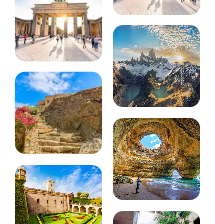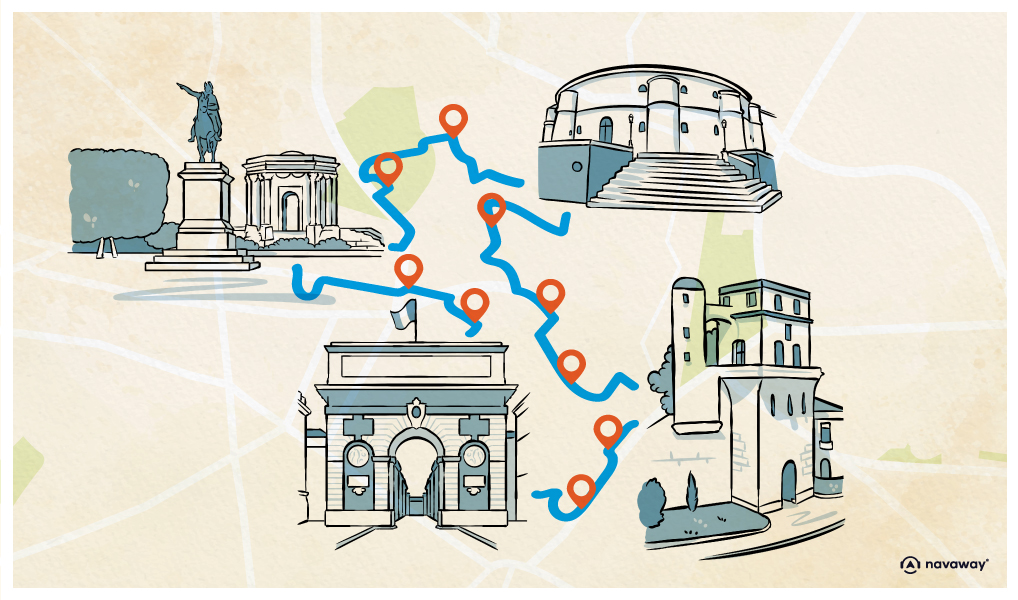
20 excursions around Montpellier
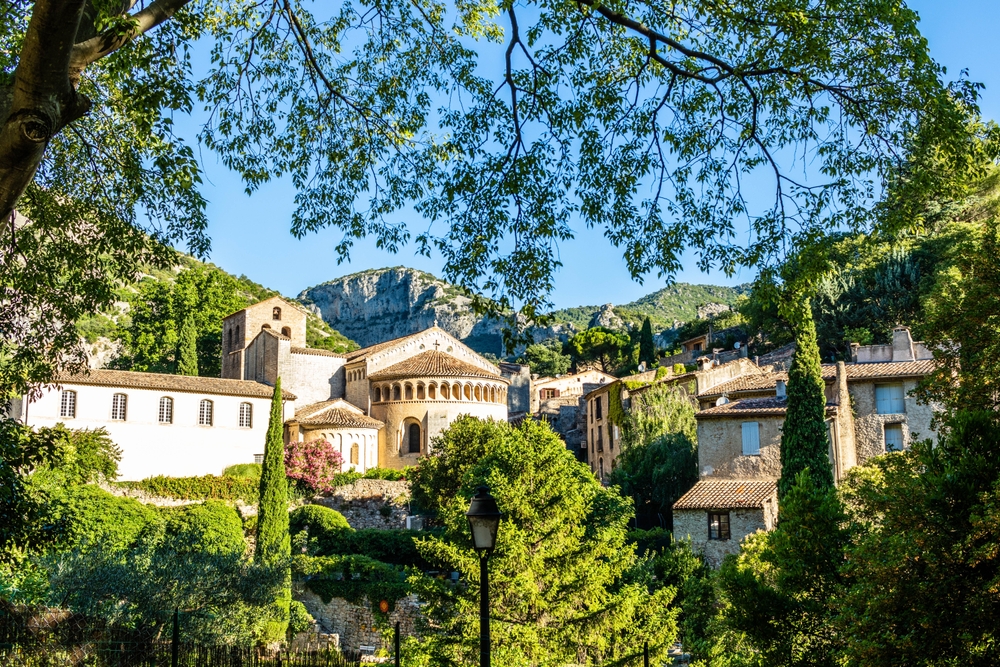
Montpellier, nicknamed the “Gifted One”, offers privileged access to some of the most beautiful destinations in the Languedoc and Occitanie regions. Whether you want to discover medieval villages, exceptional natural sites or cities of art and history, there’s no shortage of excursions around Montpellier to enrich your stay. Here is our selection of the 20 best excursions around Montpellier to discover the treasures of this magnificent region.

Also read the Montpellier guide :
- 20 must-see weekend ideas around Montpellier
- The best activities in and around Montpellier
- The 6 best beaches in Montpellier
- Montpellier’s culinary specialities
- The 10 best bike rides in and around Montpellier
- What to do around Montpellier with your family?
- Top 4 events in Montpellier
- The 9 best straw huts near Montpellier for an unforgettable summer
1. Saint-Guilhem-le-Désert: medieval jewel and world heritage site
Just 40 kilometres from Montpellier, Saint-Guilhem-le-Désert is the perfect way to discover one of France’s most beautiful villages. Listed as a UNESCO World Heritage Site, this medieval village boasts the Gellone Abbey, cobbled streets and an exceptional setting in the heart of the Hérault gorges.
A visit to Saint-Guilhem-le-Désert takes you through its well-preserved historic centre, with its blond stone houses typical of the Hérault region. TheAbbey of Gellone, founded in the 9th century, remains the key monument to discover, with its church and the remains of its Romanesque cloister. Don’t miss the famous waterfall that flows peacefully through the heart of the village.
Download the audio-guided tour to discover Montpellier on foot and on your own
To enhance your discovery of the region, we recommend that you start by exploring Montpellier with our audio tour of Montpellier. This 19-stop itinerary takes you on a tour of Montpellier’s must-sees, from the Place de la Comédie to the Promenade du Peyrou, via the Écusson and Saint-Pierre Cathedral. Let us guide you on your visit to Montpellier with this optimised Navaway itinerary that reveals all the secrets of this dynamic city.
Practical info: 45-minute drive from Montpellier. Possibility of guided tours and hikes in the surrounding gorges.
2. Sète: the Venice of Languedoc and its canals
Nicknamed the “Venice of the Languedoc”, Sète is just 30 kilometres from Montpellier and makes a perfect day trip. This unique port city boasts canals, an authentic fishing port and ancient maritime traditions.
Climbing Mont Saint-Clair offers exceptional views over the town, the Etang de Thau and the Mediterranean Sea. The marine cemetery, made famous by Paul Valéry, is a place of remembrance steeped in history. Culture lovers will love theEspace Georges Brassens, dedicated to the famous singer and native of the town.
The port of Sète, the leading fishing port in the French Mediterranean, is a great place to discover the authentic maritime life of the Languedoc region. Nautical jousting, a centuries-old tradition, regularly livens up the canals during the summer festivities.
Practical info: Accessible by train (33 minutes) or car (35 minutes). Daily market and numerous restaurants serving local specialities.
3. Nîmes and the Pont du Gard: immersion in ancient Rome
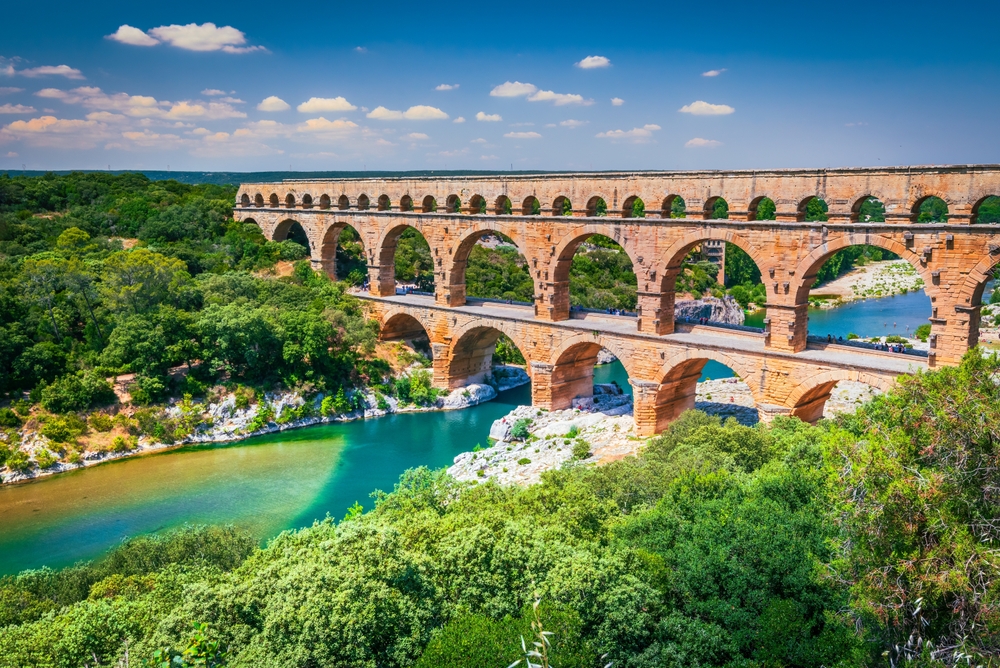
A trip to Nîmes and the Pont du Gard takes you back 2,000 years to the days of Roman Gaul. Just 56 kilometres from Montpellier, Nîmes boasts one of the best-preserved ancient heritages in Europe, with its emblematic monuments.
The Nîmes Arena, a remarkably well-preserved Roman amphitheatre, still hosts shows and bullfights. The Maison Carrée, an intact Roman temple, is a unique example of ancient architecture. The Musée de la Romanité is the perfect complement to the visit, showcasing the region’s archaeological collections.
The Pont du Gard, 20 minutes from Nîmes, is a masterpiece of Roman engineering. This 49-metre-high aqueduct, a UNESCO World Heritage site, is a testament to the architectural genius of the period. The site also offers family activities and a modern museum.
Practical info: Accessible by train (24 minutes) or car (55 minutes). Guided tours available. Free entry to the Pont du Gard for pedestrians.
4. Aigues-Mortes and the Camargue: between ramparts and wilderness
Aigues-Mortes, a fortified medieval town, offers a breathtaking excursion 32 kilometres from Montpellier. Its perfectly preserved ramparts and Tour de Constance tell the story of Saint Louis’ crusades and the Wars of Religion.
The town is also the gateway to the Camargue, an exceptional natural area where bulls, horses and pink flamingos roam free. The Aigues-Mortes salt marshes offer visitors the chance to take a trip on a small train to see how the salt is extracted and to observe the Camargue wildlife.
Les Saintes-Maries-de-la-Mer, an hour’s drive from Aigues-Mortes, is a perfect complement to this excursion, with its fortified church and gypsy traditions. The Camargue Regional Nature Park offers plenty of opportunities for hiking and birdwatching.
Practical info: 35 minutes by car. Direct bus line 106. Guided tours of the ramparts and excursions to the Camargue.
5. Lac du Salagou and Cirque de Mourèze: lunar landscapes
The Lac du Salagou and Cirque de Mourèze are an exceptional nature excursion just 54 kilometres from Montpellier. These remarkable geological sites offer strikingly colourful landscapes, with red earth and spectacular limestone formations.
The artificial Salagou lake has a striking red shoreline, due to the presence of iron oxide in the rock. This unique setting is ideal for water sports, hiking and mountain biking. The villages of Celles and Liausson add a heritage dimension to this natural discovery.
The Cirque de Mourèze transports you into a fascinating mineral universe, with its dolomites of astonishing shapes. This “sea of rocks” offers a family discovery trail where imagination brings to life the limestone silhouettes: the Sphinx, the Bear, the Orgues… The panorama from Mount Liausson takes in the whole site.
Practical info: 50 minutes by car. Free car park. Marked hiking trails and picnic area.
6. Pic Saint-Loup: hiking and exceptional vineyards
The Pic Saint-Loup rises majestically 30 kilometres from Montpellier, offering an excursion combining hiking and wine tourism. This emblematic summit of the Hérault region rises to 658 metres and offers exceptional panoramic views over the region.
The ascent to the peak, which takes 2? hours, rewards walkers with a 360° view of Montpellier, the Mediterranean, the Cévennes and the Pyrenees on a clear day. The path crosses typical Mediterranean scrubland, rich in aromatic plants and wild orchids.
The Coteaux du Languedoc AOC Pic Saint-Loup appellation produces wines of international renown. The region’s wineries offer tastings and tours of their cellars, enabling visitors to discover Mediterranean grape varieties and modern winemaking techniques.
Practical info: 40 minutes by car. Several hiking trails start from the surrounding villages. Tastings at the wineries.
7. La Grande-Motte and its beaches
La Grande-Motte is the perfect seaside excursion from Montpellier, just 24 kilometres away. Created in the 1960s, this modern seaside resort boasts avant-garde architecture and fine sandy beaches.
The Grand Travers beach stretches for several kilometres and offers a full range of water sports facilities, including sailing, paddle-boarding, jet-skiing and catamaran sailing. Modern tourist facilities include a casino, marina and thalassotherapy centres.
The characteristic pyramid-shaped architecture of La Grande-Motte, designed by Jean Balladur, creates an urban landscape that is unique on the Mediterranean coast. The seafront promenade allows you to admire these emblematic buildings while enjoying the lively summer season.
Practical info: 30 minutes by car. Pay car park in season. Numerous water sports activities and beach restaurants.
8. Pézenas: in the footsteps of Molière
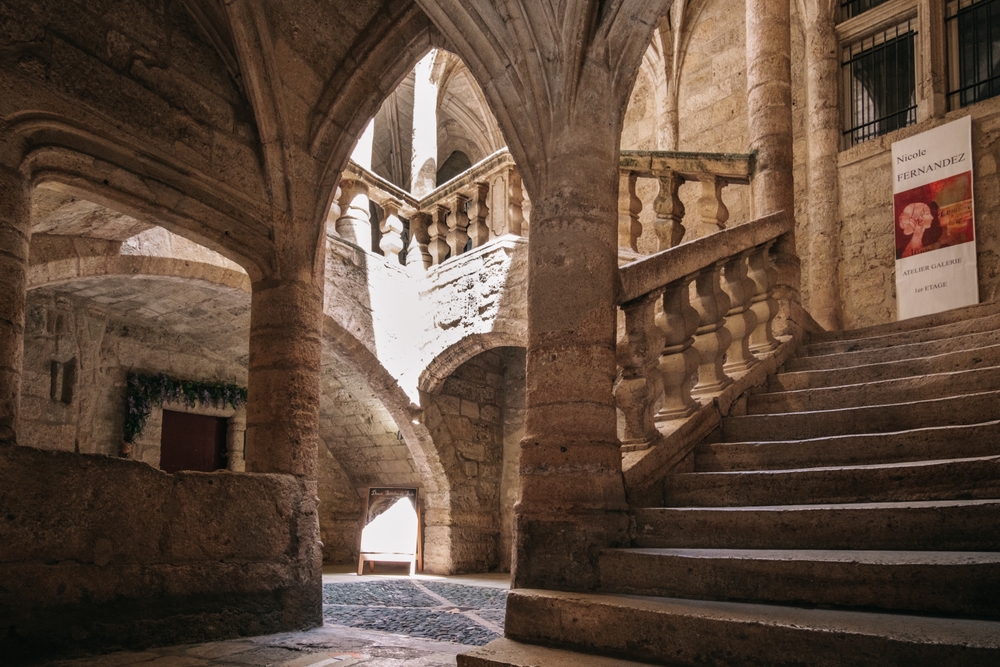
Pézenas, 57 kilometres from Montpellier, invites you to discover the town where Molière stayed and created some of his most famous works. This town of character has preserved a remarkable architectural heritage dating from the 16th to 18th centuries.
The historic centre of Pézenas boasts more than 30 mansions and houses full of character. The Estates of Languedoc met here regularly, attracting a refined society that left a lasting mark on local architecture and culture. The Maison Consulaire and the Hôtel de Lacoste bear witness to this splendid era.
Arts and crafts play an important role in Pézenas, with its many traditional workshops: ironwork, pottery, marquetry and tapestry. The Musée de Vulliod-Saint-Germain presents the local history and traditions of Pézenas, while the Scénovision Molière retraces the playwright’s stay in the region.
Practical info: 45 minutes by car. Saturday morning market. Molière Festival every summer.
9. Béziers and the Canal du Midi
Béziers, the prefecture of the Hérault department, 71 kilometres from Montpellier, combines historic heritage and technical prowess with the famous Canal du Midi. This thousand-year-old city overlooks the Orb valley and reveals a rich architectural past.
The cathedral of Saint-Nazaire, perched on its hill, majestically dominates the town and the surrounding plain. The medieval historic centre, with its cobbled streets and shady squares, is an inviting place to stroll around. The Musée du Biterrois traces the history of the area back to Roman times.
The Fonsérannes locks, a staircase of nine successive locks, are a masterpiece of 17th-century engineering. The Orb canal bridge enables boats on the Canal du Midi to cross the river, offering a breathtaking technical spectacle. River cruises allow you to discover these works of art from the water.
Practical info: Accessible by train (45 minutes) or car (1 hour). Cruises on the Canal du Midi. Feria in August.
10. Sommières: medieval charm on the Vidourle river
Sommières and the neighbouring village of Villevieille offer an authentic excursion just 36 kilometres from Montpellier. This medieval town, on the banks of the Vidourle river, boasts a well-preserved heritage and a Provencal atmosphere.
The Tibetan Roman bridge, built in the 1st century, still spans the Vidourle after 2000 years. Some of its arches are buried beneath medieval buildings, creating a unique architectural ensemble. Sommières castle has dominated the town since the 11th century.
The historic centre reveals its treasures as you stroll along its cobbled streets: arcaded houses, town houses, market square… In Villevieille, the medieval castle and wine-tasting cellars round off this discovery of the Gard region’s heritage.
Practical info: 40 minutes by car. Saturday morning market. Beware of flash floods on the Vidourle (Vidourlade).
11. Gorges de l’Hérault and Pont du Diable
The Hérault Gorges offer a spectacular nature excursion just 40 kilometres from Montpellier. This steep-sided valley, carved out by the river Hérault, reveals wild Mediterranean landscapes and authentic hilltop villages.
The Pont du Diable, a UNESCO World Heritage site, is the jewel in the crown of this tour. This 11th-century Romanesque bridge, with its mysterious legends, spans the Hérault in an unspoilt natural setting. The crystal-clear waters invite you to take a dip on a hot summer’s day.
Canoeing from Saint-Guilhem-le-Désert allows you to discover the gorges from the river. This family activity reveals the geological and botanical wealth of the area, with its limestone cliffs, caves and Mediterranean riparian vegetation. Several water sports centres offer equipment hire and supervision.
Practical info: 40-minute drive to Pont du Diable. Canoeing and kayaking from March to October. Pay car park in season.
12. Cap d’Agde: seaside resort and heritage
Cap d’Agde, 67 kilometres from Montpellier, is the perfect combination of seaside relaxation and cultural discovery. This modern tourist resort is built around a marina and characteristic black volcanic sand beaches.
The historic centre ofAgde, the “Black Pearl of the Mediterranean”, boasts an exceptional heritage dating back thousands of years. The cathedral of Saint-Étienne, a fortress of black basalt, is a testament to the Romanesque architecture of Languedoc. The Musée de l’Éphèbe displays exceptional collections of underwater archaeology.
The Bagnas Nature Reserve protects a remarkable lagoon ecosystem, home to pink flamingos, herons and many migratory species. Observation trails are available to discover this preserved biodiversity. Families will love the Aqualand and Luna Park leisure parks.
Practical info: 1 hour by car. Regular trains to Agde, then bus to Le Cap. Marina and numerous water sports activities.
13. Cirque de Navacelles: Grand Site de France

The Cirque de Navacelles, a Grand Site de France located 71 kilometres from Montpellier, offers one of the most spectacular nature excursions in the region. This natural amphitheatre, carved out by the Vis river, boasts impressive dimensions and breathtaking scenery.
The lookout point at Blandas offers a breathtaking view of this abandoned 300-metre-deep meander. The contrast between the limestone plateaux of the Causses and the green backdrop of the cirque creates a landscape of striking beauty. The small village of Navacelles, at the far end of the cirque, seems crushed by the immensity of the site.
The Vis resurgence cascades from a cave to form a crystalline torrent. An old mill bears witness to past human activity on this grandiose site. A number of hiking trails offer a variety of views of the cirque, particularly from the villages of Saint-Maurice-Navacelles and Blandas.
Practical info: 1h10 by car. Winding mountain road. Picnic area and restaurant in Navacelles.
14. Uzès and its ducal heritage
Uzès, France’s first duchy, offers a refined excursion just 82 kilometres from Montpellier. This town in the Gard region boasts well-preserved Renaissance architecture and an authentic Provencal way of life.
The Place aux Herbes, surrounded by medieval arcades, is the beating heart of Uzès, with its colourful market and shady terraces. The Duchy of Uzès is open to visitors and reveals the history of this thousand-year-old ducal lineage. The Fenestrelle Tower, unique in France with its Byzantine silhouette, elegantly dominates the city.
The Haribo Museum, with its collections of sweets and its giant shop, is a real treat for food lovers. The medieval garden recreates the art of gardening in the Middle Ages, with its dyeing and medicinal plants. The proximity of the Pont du Gard (15 minutes) means you can combine the two visits in the same day.
Practical info: 1h15 by car. Market on Wednesdays and Saturdays. Visit the Duchy in season.
15. Arles: Roman heritage and Van Gogh
Arles, an exceptional Roman city 80 kilometres from Montpellier, combines ancient heritage and modern art in an authentic Mediterranean setting. This city of art and history reveals 2,000 years of European civilisation.
The perfectly preservedRoman amphitheatre is still home to Camargue races and shows. The ancient theatre and Constantine’s baths bear witness to the grandeur of Roman Arelate. The Musée départemental Arles antique boasts exceptional archaeological collections, including the presumed bust of Julius Caesar.
The Vincent van Gogh Foundation celebrates the work of the painter, who spent his last creative years here. TheEspace Van Gogh, a former hôtel-Dieu painted by the artist, now houses a media library. The Alyscamps, an ancient and medieval necropolis, inspired many painters and poets.
Practical info: Accessible by train (52 minutes) or car (1h05). Monuments pass. Photography festival every summer.
16. Avignon: city of the Popes
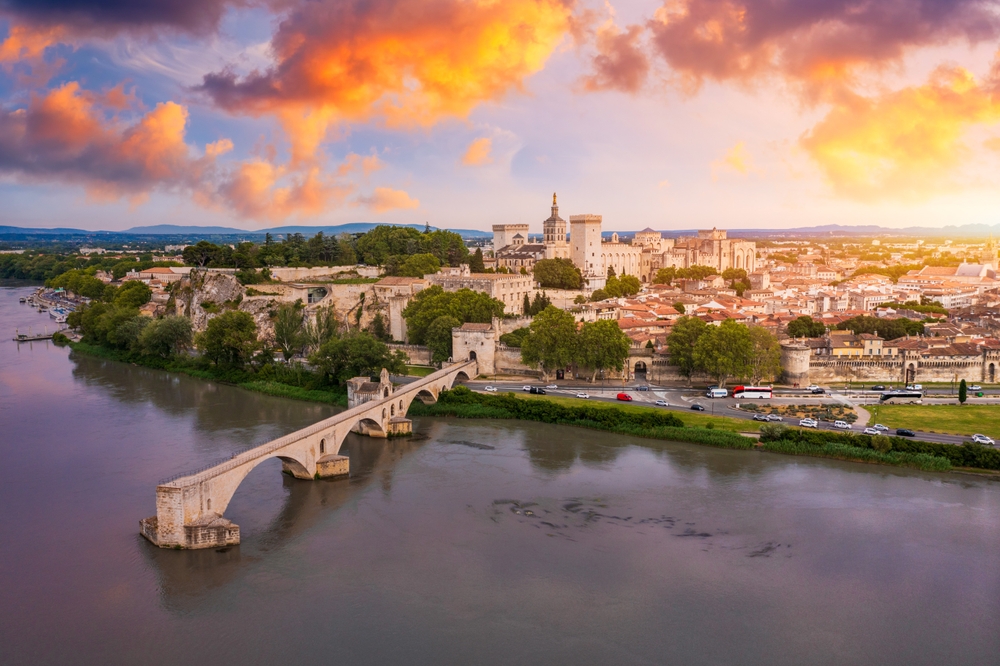
Avignon, a UNESCO World Heritage site, is a major cultural excursion just 95 kilometres from Montpellier. This pontifical city boasts an exceptional architectural heritage that bears witness to its past as the capital of Western Christendom.
The Palais des Papes, the largest Gothic palace in the world, is impressive for its size and splendour. The papal flats, the great audience and the Clementine Chapel bear witness to the refinement of the 14th-century papal court. The audio tour reveals the eventful history of this unique residence.
The famous Saint-Bénézet bridge, known as the “Pont d’Avignon”, has spanned part of the Rhône since the 12th century. The 14th-century ramparts still encircle the city and offer a refreshing walk. The Avignon Festival, created in 1947, transforms the city into the world capital of theatre every summer.
Practical info: Accessible by train (1h12) or car (1h15). Avignon pass for the monuments. Booking recommended for the Festival.
17. Les Aresquiers beach: unspoilt nature
The Aresquiers beach, located 31 kilometres from Montpellier, offers a natural escape from the urbanised seaside resorts. This natural pebble beach, the longest in the département, has a wild and unspoilt character.
The exceptional natural environment of Les Aresquiers is home to flora and fauna typical of the Mediterranean coastline. The dunes and riparian vegetation are fragile ecosystems protected by the Conservatoire du Littoral. The tranquillity of the site is ideal for birdwatching and relaxing in the fresh air.
This is the ideal setting for water sports activities such as sea kayaking, sailing and scuba diving. Several centres offer introductory and advanced courses in a safe environment. Sunsets over the Mediterranean offer magical moments for photographers and contemplative types.
Practical info: 40 minutes by car. Free car park. No shops on site, so bring your own supplies.
18. Caves de Roquefort: an exceptional terroir
The Caves de Roquefort Société, 116 kilometres from Montpellier, offer a unique gastronomic excursion to the heart of Aveyron. This discovery of the “King of cheeses” takes you into the bowels of the causses where this exceptional product is matured.
The natural caves of Roquefort, dug into the limestone rock, benefit from an exceptional microclimate. The constant temperature of 8°C and humidity of 95% allow the famous Penicillium roqueforti to thrive. The guided tour reveals the secrets of making this raw sheep’s milk cheese.
The museum and shop complement this discovery with the history of cheese production since the Middle Ages. The tasting session, the highlight of the visit, allows visitors to appreciate the different textures and flavours depending on the maturing process. The restaurant offers creative cuisine entirely dedicated to Roquefort.
Practical info: 1h25 by car. Guided tour recommended. Shop and delivery available.
19. Palavas-les-Flots and its seaside tradition
Palavas-les-Flots, just 13 kilometres from Montpellier, is Montpellier’s historic seaside resort. This family-friendly destination combines maritime tradition and modern tourism in an authentic Mediterranean setting.
The Little Beach Train runs from Palavas to La Grande-Motte along the sandy coastline. This bucolic ride reveals the diversity of coastal landscapes: ponds, reed beds, dunes and fishing ports. TheMare Nostrum Aquarium features spectacular reconstructions of Mediterranean and tropical fauna.
The cathedral of Maguelone, accessible by a dike road, stands majestically on its islet in the middle of the lakes. This jewel of Languedoc Romanesque art, a former episcopal residence, offers an exceptional spiritual and cultural setting. The best places to visit in Palavas-les-Flots also include the Mediterranean lighthouse and the summer night market.
Practical info: Accessible by tram (line 3) or car (20 minutes). Pay car park in season. Shuttle service to Maguelone.
20. Clamouse cave: underground wonders
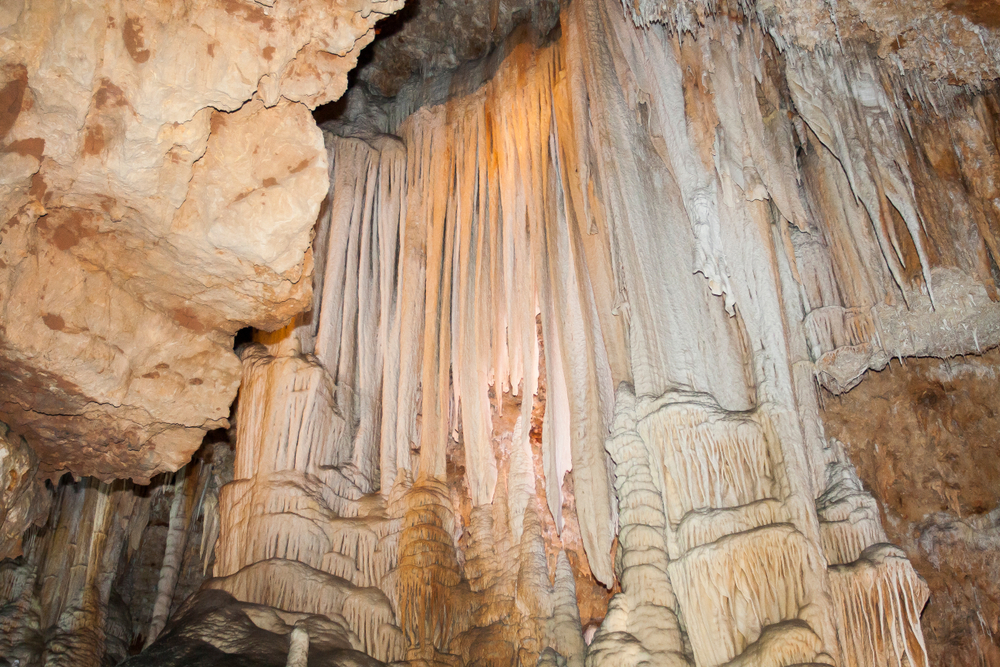
The Grotte de Clamouse, near Saint-Guilhem-le-Désert, 45 kilometres from Montpellier, is the perfect way to explore the gorges de l’Hérault and the exceptional underground world of the Causses.
This natural cave reveals extraordinarily fine limestone concretions: fistulas, draperies, columns, gours… The geological wealth of Clamouse has earned it the nickname “the cave of a thousand and one wonders”. The play of light highlights the transparency and purity of these age-old formations.
The 1 kilometre underground route takes you through immense chambers with evocative names: the Giant Guru chamber, the Fistula gallery, the White chamber… The constant temperature of 17°C provides welcome coolness on hot summer days. The one-hour guided tour reveals the geological formation of the Causses and karstic hydrology.
Practical info: 45 minutes by car via Saint-Guilhem-le-Désert. Free parking. Bring warm clothing and non-slip shoes.
In conclusion, the excursions around Montpellier reveal an exceptional diversity of landscapes, heritage and experiences. From medieval villages to grandiose natural sites, ancient remains and maritime traditions, the Occitanie region offers an unrivalled wealth of heritage. To make the most of your stay, why not visit Montpellier with our interactive audio guide, which will reveal all the secrets of this dynamic city before setting off to discover its wonderful surroundings.
Frequently asked questions
What’s the best day out around Montpellier?
Saint-Guilhem-le-Désert remains the most emblematic excursion around Montpellier. This medieval village, listed as a UNESCO World Heritage Site and awarded the title of “Most Beautiful Village in France”, combines history, architecture and nature in the exceptional setting of the Hérault gorges.
Is it possible to do several excursions around Montpellier without a car?
Yes, several destinations are accessible by public transport. Sète can be reached by train in 33 minutes, Nîmes in 24 minutes, Béziers in 45 minutes and Arles in 52 minutes. There is also a bus service to Aigues-Mortes (line 106), and a number of organised excursions are offered by local tour operators.
What excursion should you choose with children around Montpellier?
La Grande-Motte and its beaches, Cap d’Agde with Aqualand, and Palavas-les-Flots with its Mare Nostrum aquarium are perfect excursions for families. The Cirque de Mourèze is another fun place to explore, with its amusingly shaped rocks.
How long should you allow for an excursion around Montpellier?
Most of the excursions around Montpellier can be visited comfortably in a day. For nearby sites (Saint-Guilhem, Sète, Pic Saint-Loup), half a day may suffice, while more distant destinations such as Avignon, Arles or the Caves de Roquefort merit a full day.
When is the best time of year for excursions around Montpellier?
Spring (April-June) and autumn (September-October) offer ideal conditions: pleasant temperatures, fewer crowds and lush green landscapes. Summer is the time to enjoy water sports and beaches, while winter is mild enough to visit cultural and heritage sites.
200 audioguided tours for cities all around the world
Download